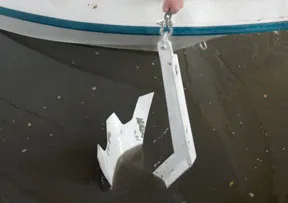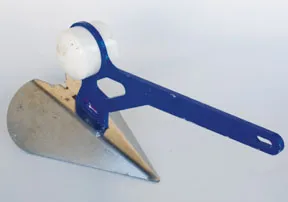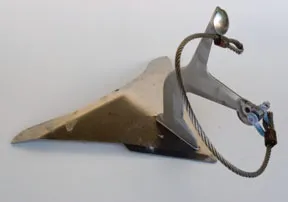
Practical Sailor’s mud anchor review would not be complete without testing some of the more expensive and exotic designs on the market today. In this follow-up to February’s test of inexpensive anchors in soft mud, we look at a variety of products from faraway places like Australia and New Zealand, as well as a number of homegrown engineered steel and aluminum creations. Reader input and an editorial staff desire to perform an analysis under both nominal and extreme conditions had us testing at two significantly different scope lengths again. The short 3:1 scope test gave us a good indication of how an anchor would perform when set in an area where your ability to pay out a typical 7:1 scope is constrained for some reason. We also tested at the more typical 7:1 scope for baseline results.
What We Tested
This group consists of hooks priced from $200 to nearly $500. Sizes vary, but most of the anchors have a suggested boat length of about 28 to 35 feet. As a whole, this group covers boat lengths from 20 to 45 feet. Designs vary from the common Danforth-style to hybrids that defy description.
The field includes, from Anchor Right Australia, the Sarca; from Tie Down Engineering, the Danforth Deep Set II; and from Fortress, the FX-23. Kingston supplied its Plow while Super Max sent adjustable and rigid shank versions of their namesake anchor. We also tested the Bulwagga, the Davis Talon XT, the HydroBubble, the Rocna 15, the Spade, and the XYZ.
Anchor Right Sarca
Anchor Right Australia produces the Sarca (Sand and Rock Combination Anchor), an anchor we’d describe as a hybrid plow-style, in 13 sizes in both hot-dipped galvanized steel and stainless steel. We tested a galvanized No. 4. It has a couple of features not seen on most other plow-style anchors: a hoop on the rear of the anchor and a full-length slotted shank. According to Anchor Right, the hoop does two things: It facilitates rollover should the anchor land on the bottom inverted and it keeps chain from tangling in the flukes. The slotted shank serves as an automatic trip to allow easy anchor removal from rocky bottoms.
Overall performance of the Sarca was very good. It hit and held 500 pounds at a 7:1 scope as well as managing to hold 420 pounds at a 3:1 scope. We rated it Good and Fair for setting in our pair of tests—it took two attempts to set on one test. Our Sarca No. 4 weighed in at 30 pounds. We found it priced at $412 and carries a five-year warranty.
Bottom Line: A good overall performer with a rather stiff price tag. This anchor may be difficult to locate and purchase in the U.S., but it can be ordered from the company’s website.
Bulwagga
This symmetrical three-fluke design constructed from galvanized steel has done well in our previous anchor tests. In those tests, it hit big holding power numbers when tested on long scopes and stayed buried in our veer test. Downsides mentioned before were difficulty carrying and stowing the Bull. The company website has answered some of these complaints by showing ways to stow the anchor in the pulpit or bow anchor roller on some larger boats. On boats with smaller anchor lockers, you would be hard pressed to stow this anchor.
The Bulwagga definitely favored the longer scope of our 7:1 test where it hit 500 pounds and held 480. It only dragged about 3 feet. When tested at the shorter 3:1 scope we could never hit our target of 500 pounds, it just dragged 15 feet through the mud at 450 pounds. The Bulwagga is priced at $238 and carries a one-year warranty.
Bottom Line: The Bulwagga provides easy sets and good holding power when strung on a long scope, but it can be hard to store on a small boat.
Danforth Deep Set II
Tie Down Engineering bought Danforth Anchors from Rule in 2000 and today markets the Danforth brand name. The Deep Set II that we tested is constructed from hot dipped galvanized premium steel in a very strong configuration that boasts a shank tensile strength of 200,000 psi.
On the long scope, the Danforth set easily and managed to hold 450 pounds of pressure. At the short 3:1 scope the Deep Set II managed to hit 500 pounds then fell right off to 350 once the pull stopped.
The Danforth 23-pound Deep Set II is priced at $249 and carries a lifetime warranty.
Bottom Line: The popular Danforth performs well under a variety of conditions but slips in soft mud at short scopes.
Davis Talon XT
The Talon XT from Davis Anchor is a plow-style anchor available in eight sizes in either galvanized or stainless steel. The Talon XT performed equally at both the long and short scope. It set right away both times and hit 500 pounds after pulling 10 feet of line at the short scope and 15 feet of line at the long scope. Holding power was rated 450 pounds at both scopes, high on our list. Our test anchor was a galvanized X35 model weighing in at 36 pounds; it cost $275 and has lifetime warranty against breakage.
Bottom Line: Good holding power at both scopes and a top-shelf warranty put the Talon XT in with the leaders.
Fortress FX-23
Fortress builds aluminum Danforth-style, twin-fluke anchors that are significantly lighter in weight than their comparably sized steel competitors. We tested an FX-23. This anchor has a bright-anodized finish. Assembly is required prior to use; however, it took only a few minutes to put together, and the fact that the anchor can be disassembled means less storage space is needed should the anchor be stowed long-term.
Mud palms, a small aluminum plate that bolts to the crown of the anchor, are standard equipment on all Fortress anchors. Fortress claims the mud palms make the anchor set faster in any type of bottom and recommends they be permanently installed. We installed them on the FX-23. One other feature found only on the FX-series is an adjustable fluke angle; it can be changed from the standard 32 degrees to 45 degrees to provide more holding power. Fortress recommends using only the 45-degree position in soft mud bottoms with very poor holding power as the anchor will not set in firmer bottoms when in the 45-degree position. They recommend keeping the anchor in the standard 32-degree position until extra holding power is needed. We tested in the standard 32-degree position, but we will be following up on the design’s performance in the 45-degree configuration.
The FX-23 performed above average at the short 3:1 scope by setting easily and holding 375 pounds. At the more typical 7:1 scope, it performed with the best by holding 475 pounds. The light weight of the FX-23 made it easy to carry around especially when compared to some of the other behemoths in this group.
The FX-23 is priced at $269 and carries a lifetime warranty.
Bottom Line: This lightweight Fortress is easy to tote, carries a great warranty, and holds with the best at a 7:1 scope. Holding power trails off at short scopes.

HydroBubble
Several models and sizes of the HydroBubble are available, even an anchor with breakaway capabilities. Construction materials can be a combination of aluminum alloy and stainless steel or galvanized steel. The common element in all the anchors is a sealed flotation chamber fitted to the shank that, according to the maker, always brings the plow to rest in the proper position to dig into the bottom. We tested the Standard Series model 45. It performed superbly in the mud, earning a Good set rating at the short scope and an Excellent on the long scope, holding 480 pounds at both scopes. This anchor has a limited lifetime warranty.
Bottom Line: The mid-priced HydroBubble ($249) is an excellent soft mud performer with an outstanding limited lifetime warranty.
Kingston Plow
The Kingston Plow is a CQR look-a-like. It is constructed from galvanized steel and is available in five weights, from 20 to 60 pounds. Ours weighed 36 pounds. This anchor set easily in both tests earning Good and Excellent rating. On the long scope it hit 500 pounds then fell right off to 380 once the pull stopped. It dragged about 12 feet. On the short scope it managed to hold 450 pounds, but again dragged about 10 feet. It seems this particular model of anchor does not hold well in soft mud.
Kingston anchors carry a lifetime warranty. We found the 36-pound Plow for $249.
Bottom Line: The Kingston Plow held a fair amount of strain but dragged too far for our liking.
Spade A80
The original bolt-together, two-piece Spade anchor is now available in aluminum, galvanized steel, or stainless steel in six different sizes. We tested an all-aluminum Spade A80. It carries a lifetime warranty against breakage. In our long scope test it set immediately, earning an Excellent set rating. When we spun up the winch, it hit 500 pounds in just a few feet of pull and held steady at 460 pounds while dragging only two feet—very good, top-of-the-heap performance. It did not, however, like the short 3:1 scope. Though it set right away, it could not hit our target load and simply dragged through the slippery mud at 250 pounds.
Bottom Line: This anchor has fared well in previous tests, but not this time. And ouch! The $449 price is steep.
Super Max
The Super Max Pivoting and Super Max Rigid are very similar in design, both are scoop-style anchors with a concave, shovel-shaped palm constructed from hot-dipped galvanized steel. They are available in six sizes ranging from 18 to 115 pounds. Both of the anchors we tested were Max 16 models. These two were by far the biggest, bulkiest, and heaviest anchors in the field.
The pivoting Super Max has a three-position hinge located about mid-shank that can be adjusted for bottom composition. The lowest position is for sand, the middle for mud, and the highest for ooze and soup. We tested it in the middle position.
In performance testing we found both anchors set easily on the first attempt in all tests. In the long scope test, the Super Max Rigid hit 500 pounds after a long pull and then fell right off to 425 once the pull stopped. It felt like we were dragging the bucket of a front-end loader through the mud. The pivoting model performed similarly: After pulling 15 feet of line, it hit our 500-pound target. At the shorter scope the pivoting anchor hit 500 pounds then fell right off to 400. The Rigid model, in a 10-foot pull, hit 350 pounds, broke loose, and finally hooked up again and hit 300.
These are expensive anchors with both the 45-pound Super Max Pivoting model 16 and the 47-pound Super Max Rigid model 16 each priced at $475, the highest of any anchors in our test. Super Max anchors carry a one-year warranty.
Bottom Line: With only average performance and a very high price tag, we’d take a pass on these if we expected to anchor mostly in soft mud.
Rocna 15
The Rocna was designed in New Zealand and is built in Canada. We’d describe it as a plow-style anchor with a roll bar fitted at the rear of the foot. It is constructed of galvanized steel and is available in 11 sizes from 9 to 243 pounds. The maker claims the roll bar, plus the chisel tip and skid rails on the foot, will always force the Rocna to dig in to any bottom. We had no trouble setting this anchor in either test and rated it Good in both tests.
At the long scope it performed well, hitting 500 pounds and then holding 440 pounds while only dragging about 6 feet. It did not do as well at the short scope where it dragged through the mud at 300 pounds. We found the 28-pound Rocna 15 priced at $383. Like all Rocna anchors, it carries a lifetime warranty against manufacturer defects.

Bottom Line: Expensive with less than stellar holding power when set on a short scope.
XYZ
The XYZ website describes the anchor as “a radical departure from conventional anchor design.” We’d have to agree: In our last test we thought this anchor looked more like a sculpture than an anchor with its low-profile plow, the extra projection on the shank, and the short section of wire cable fastened to the shank eye. The XYZ we tested is the only size currently available and it weighs just 13 pounds. It may look odd, but this all stainless-steel anchor topped the list in performance in our soft mud test. It set easily both times and managed to hit and hold 500 pounds at both scopes. The anchor dragged only a few feet in each test. It is quite expensive though, carrying a price tag of $395. The warranty period is one year.
Bottom Line: Though very pricey, its light weight and superior performance in the soft mud bottom earned the XYZ anchor a top pick.
Conclusions
We have to wonder—based on the prices they seek—whether some of these anchor makers think their products are made from unobtainium rather than steel or aluminum. For us to select an anchor that costs nearly $400 as top pick when you can get nearly equal results at far less expense, the anchor needs to perform impeccably. Otherwise we’d seek out a less expensive product every time. The only anchor that performed at that level was the XYZ. We awarded it a top pick based on its performance. Other top performers, in order, were the HydroBubble, Bulwagga, and Davis Talon. All three are substantially less expensive than the XYZ. The HydroBubble performed nearly equal to the XYZ while both the Bulwagga and Davis trailed a step behind.
Also With This Article
“Value Guide: Anchors For Soft Mud (Over $200)”
“How We Tested”
Contacts
• Anchor Right Australia, +61-3/598-4470, www.anchorright.com.au/
• Bulwagga Marine Anchors, www.noteco.com/bulwagga/
• Davis Anchor & Marine, 800/328/4770, www.davisanchor.com
• Fortress Marine Anchors, 800/825-6289, www.fortressanchors.com
• HydroBubble Anchors, 888/282-2535, www.anchorconcepts.com
• Kingston Anchors, 613/549-2718, www.kingstonanchors.com
• Rocna Anchors/Suncoast Marine, 604/781-8347, www.rocna.com
• Spade Anchors, www.spade-anchor.com
• Super Max, 800/824-0355, www.creativemarine.com
• Tie Down Engineering (Danforth), 800/241-1806, www.danforthanchors.com
• XYZ Marine Products, 212/486-3912, www.xyzmarineproducts.com


































